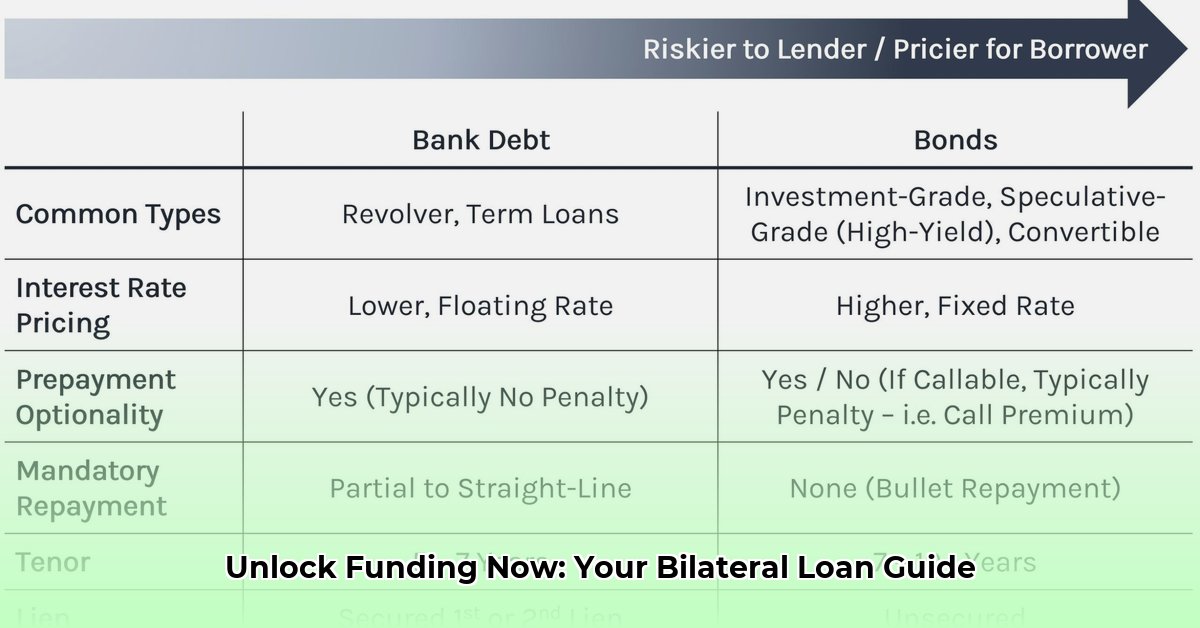
Understanding Bilateral Loans and Their Purpose
Securing funding for your business can be challenging. This guide simplifies the process of understanding bilateral loans (loans from a single lender, like a bank or credit union), highlighting their advantages and disadvantages compared to syndicated loans (loans from multiple lenders). We'll equip you with the knowledge to make an informed decision, covering cost, process, eligibility, risk, and flexibility. Whether you're a small business owner or a financial professional, this guide will provide actionable insights.
Bilateral Loans vs. Syndicated Loans: A Detailed Comparison
Choosing between a bilateral and syndicated loan depends on several key factors. This comparison will help you determine which option best suits your needs:
Cost
While precise interest rates and fees vary depending on factors like credit score, loan amount, and market conditions, bilateral loans generally entail a simpler fee structure. However, the interest rates might be higher than those offered in a syndicated loan due to the concentrated risk for the single lender. Syndicated loans, while potentially offering lower interest rates due to risk diversification among multiple lenders, may involve additional fees associated with coordinating multiple parties. The overall cost of each option requires careful evaluation based on your specific circumstances.
Process and Timeline
Bilateral loans generally boast a faster and more streamlined application process. Approval times are usually quicker, and funding disbursement is faster than with syndicated loans, which involve the coordination of multiple lenders and legal teams. Syndicated loans require significantly more documentation, negotiation, and legal review, significantly lengthening the process.
Eligibility Requirements
Eligibility criteria differ for each loan type. Bilateral loans usually have less stringent requirements, focusing on the borrower's creditworthiness, financial health, and the viability of their business plan. Syndicated loans, due to the higher loan amounts and shared risk, often demand more rigorous financial audits and comprehensive business assessments. The borrower's history, financial projections, and collateral play a vital role in eligibility determination for both loan types but are more intensely scrutinized in the syndicated loan context.
Risk
Bilateral loans present higher risk for the single lender, hence the potentially higher interest rates. For the borrower, this can translate to greater scrutiny during the application process. Conversely, syndicated loans distribute the risk among multiple lenders, reducing individual lender risk and potentially resulting in more favorable terms for borrowers who meet the stringent eligibility criteria. Managing risk for both loan types requires carefully assessing your business’s financial health and long-term projections.
Flexibility
Bilateral loans typically offer greater flexibility when negotiating loan terms, as you're dealing with a single lender. Syndicated loans often present standardized terms dictated by the syndicate's rules and risk appetite, reducing the scope for individual negotiation.
Step-by-Step Guide to Securing a Bilateral Loan
This step-by-step guide provides actionable steps for securing a bilateral loan:
- Assess Your Needs: Determine the precise loan amount and its intended purpose. A clear and well-defined plan for loan utilization will strengthen your application.
- Research Lenders: Explore different banks and credit unions, comparing interest rates, fees, and loan terms. Consider factors like their reputation and customer reviews.
- Gather Documentation: Prepare your financial documents, including income statements, balance sheets, tax returns, and business plans. Thorough and accurate documentation is key.
- Submit Application: Complete the lender’s application, providing all necessary information precisely and completely. Incomplete or inaccurate information can delay processing or lead to rejection.
- Negotiate Terms: Discuss and negotiate the loan's terms, including interest rates, repayment schedule, and any additional conditions. Don't hesitate to ask questions and seek clarification.
- Secure Funding: Once all terms are agreed upon, finalize the loan agreement and receive the funds.
Step-by-Step Guide to Securing a Syndicated Loan
Securing a syndicated loan is more complex. The process involves several key steps:
- Develop a Comprehensive Business Plan: A detailed and robust business plan highlighting the project's financial viability is crucial for attracting lenders.
- Identify Potential Lead Arrangers: Find a lead arranger (typically a large bank) experienced in arranging syndicated loans. Their expertise is vital for successful deal structuring and lender coordination.
- Prepare Extensive Documentation: Gather all necessary financial information, including detailed projections, market analysis, and risk assessments. Thorough documentation reduces complications during the process.
- Negotiate Loan Terms with the Lead Arranger: Negotiating terms with the lead arranger will shape the deal. This step will include addressing key parameters like interest rates, loan covenants, and other vital contractual aspects.
- Syndicate the Loan: Once terms are agreed upon, the lead arranger will assemble a syndicate of lenders to share the risk and provide the capital.
- Legal Review and Documentation: This is a time-consuming aspect of syndicated loans, involving multiple parties.
- Funding Disbursement: This final stage involves the disbursement of funds once all documentation and legal processes are completed.
Conclusion: Choosing the Right Loan for Your Needs
The choice between a bilateral and syndicated loan hinges on your specific financial situation, the required loan amount, and the desired timeline. Bilateral loans are generally simpler and faster but might come with higher interest rates for smaller loan amounts. Syndicated loans offer access to larger sums but involve a more complex and time-consuming application process. Carefully weigh these factors against your circumstances. Remember to consult with financial advisors to guide you in making the optimal choice.
Call to Action
Contact a financial advisor or lender to discuss your funding needs and explore the best loan options for your unique business circumstances. Their expertise will ensure you secure the right financing for your success.